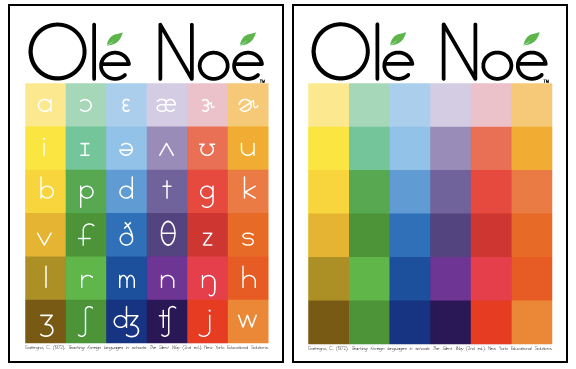The Silent Way is a language acquisition method developed by Caleb Gattegno (1972) that focuses cognition at the phonemic level. Gattegno was fascinated by first language acquisition in children and wanted to capture that full potential and power for use in second language acquisition. Since its introduction, the method has been used with both children and adults as a bottom-up process for developing auditory perception and even literacy.
Nowadays, the Silent Way is regarded as sharing certain principles with the Cognitive Approach in psychology. The initial stages of auditory perception includes detection and discrimination between sounds (Litovsky, 2015, p. 60). Gattegno’s inspiration for creating a sound-color chart was to activate a person’s innate predisposition for language acquisition. In neurophysiological terms, this means activating the complete auditory pathway from brainstem to cortex (Uppenkamp & Wierstorf, 2010, p. 382). He wanted the learner to focus on the sound system rather than the explicit linguistic information like the alphabet.
The method can be achieved with any colored paper, such as sticky notes or Cuisenaire rods. Each color arbitrarily represents a phoneme and is akin to a piano key having its own sound. We present to you the Olé Noé sound-color chart in Standard North American English (SNAE), for use in speech therapy or second language acquisition. We have seen SLPs use this method by showing infants colored sticky notes and then playing them like a piano with the target phoneme. For each color, target a specific sound, such as the bilabials /b/ and /m/. The goal is to move from unrelated vocal forms (item-based phonology) to an idiosyncratic holistic system (word-based phonology) (Vihman, Velleman, & McCune, 1994). We hope that you enjoy the Silent Way, a designer method from the 1970s that continues to inspire.
The Silent Way videos
Using Gattegno’s sound-chart in English
The Bronx Charter School for Better Learning using the Silent Way
References
Gattegno, C. (1972). Teaching foreign languages in schools: The Silent Way (2nd ed.). New York: Educational Solutions.
Litovsky, R. (2015). Development of the auditory system. In G. G. Celesia, & G. Hickok (Eds.), The human auditory system: Fundamental organization and clinical disorders (Vol. 129, pp. 55–72). Amsterdam, Netherlands: Elsevier
Uppenkamp, S., & Wierstorf, H. (2010). Representation of intelligible and distorted speech in human auditory cortex. In E. A. Lopez-Poveda, A. R. Palmer, & R. Meddis (Eds.), The neurophysiological bases of auditory perception (pp. 381–392). New York, NY: Springer.
Vihman, M. M., Velleman, S. L., & McCune, L. (1994). How abstract is child phonology? Towards an integration of linguistic and psychological approaches. In M. Yavaş (Ed.), First and second language phonology (pp. 9–44). San Diego, CA: Singular Publishing.

